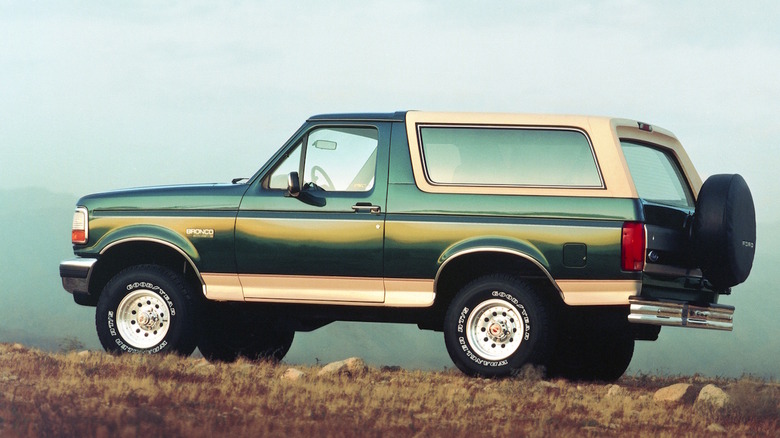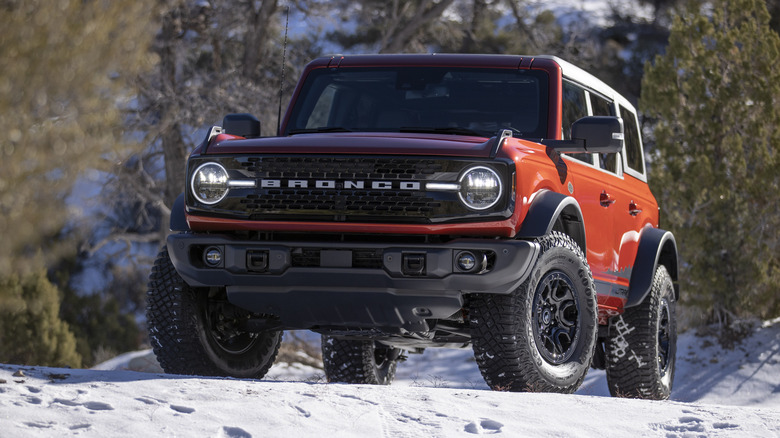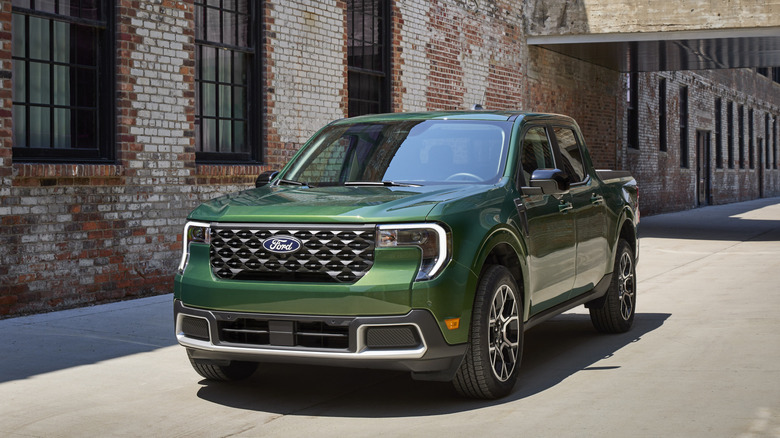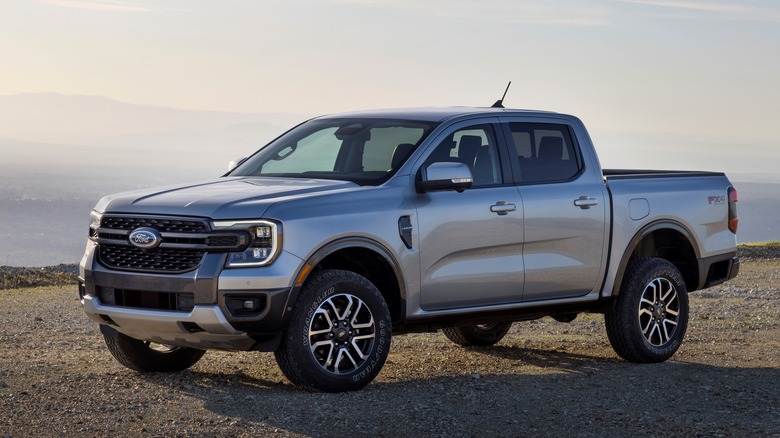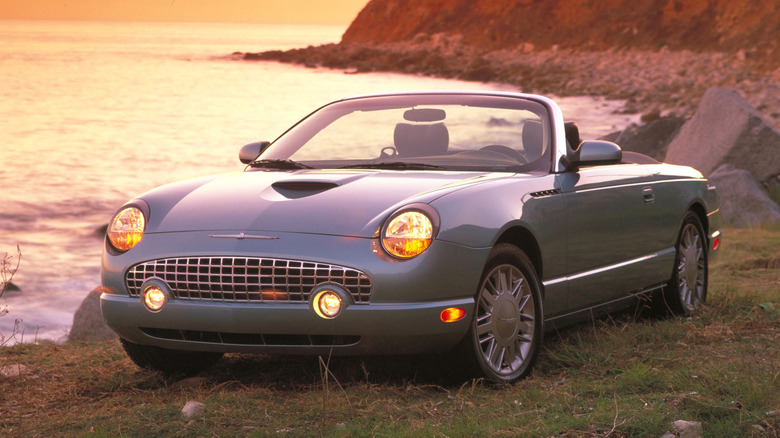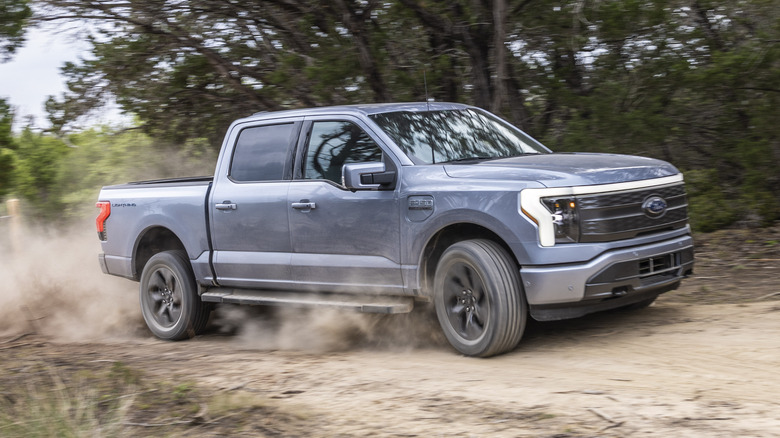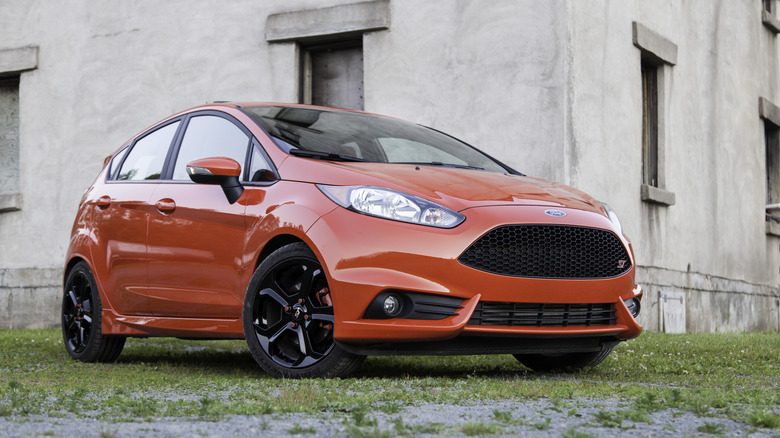6 Discontinued Ford Cars That Got A New Lease On Life
Automakers spend millions of dollars and years developing models, some of which get discontinued for various reasons. So, it's unsurprising when a name returns to the manufacturer's lineup. There's simply too much invested not to take advantage of the recognition. In particular, Ford has shown a willingness to tap into its heritage and return once-shelved nameplates to the showroom floor. It's an approach that takes advantage of a fondness for nostalgia while offering a more modern interpretation of an often iconic name.
Ford has done this on multiple occasions, most recently with the Maverick, demonstrating that bringing back a well-known model doesn't always mean the latest iteration will follow the original's form. At the same time, the return of the Bronco and Ranger shows that the Blue Oval can remain mostly faithful to the previous generations. Let's look at six Ford models that have come back from the dead, with some remaining available today, while others have once again been assigned to the dustbin of history.
Ford Bronco
Arguably, the Ford Bronco is the poster child of Ford's resurrected vehicles. The Blue Oval brought the legendary Bronco back to market for the 2021 model year after a quarter-century hiatus. The original model debuted in 1966 as a midsize SUV, competing with the Jeep CJ-5 and International Scout. By 1978, the Bronco had flexed its muscles into a full-size utility based on the F-Series pickup and was available only with V8 power. Its beefier proportions were designed to take on the equally sizable Chevrolet Blazer and GMC Jimmy.
A third generation was released in 1980, and it also shared F-Series DNA, adding a six-cylinder engine for the first time since the first generation. The fourth-generation Bronco followed in 1987, with equally bulky proportions. The fifth-generation Bronco continued to be based on the F-Series when it launched for the 1992 model year, but Ford discontinued the Bronco after 1996, letting the newly launched and four-door Expedition take over. All 20th-century Broncos have two-door body styles.
With the discontinuation of the Fusion after 2020, Ford left the sedan business and focused mainly on SUVs and trucks. Seeking to expand its lineup, the company brought back the Bronco for the 2021 model year. Based on the T6 platform shared with the Ranger pickup, the Blue Oval set its sights on the Jeep Wrangler with the sixth-generation Bronco. Like the Wrangler, the Bronco features a modular design with removable doors and roof. The Bronco's go-anywhere approach is supported by G.O.A.T. (Goes Over Any Terrain) modes and advanced four-wheel-drive systems. This time around, there's no V8 power. Instead, buyers can choose a base turbocharged 2.3-liter four-cylinder making 300 horsepower or a pair of turbo V6s, including the Bronco Raptor exclusive 3.0-liter producing 418 horsepower.
Ford Maverick
Faced with rising concerns about vehicle emissions and fuel economy, Ford released the Maverick for the 1970 model year. Slotting between the soon-to-be-discontinued Falcon and the sporty Mustang, the compact (for its day) Maverick offered a modest dash of style in conventional coupe and sedan body styles.
Ford also sought to take on the Volkswagen Beetle and its counter-culture vibe of the early 1970s. Initial Maverick marketing directly addressed the Bug, highlighting the Maverick's advantages in size and capacity. Ford also gave the Maverick tongue-in-cheek color names like Anti-Establish Mint, Hulla Blue, and Freudian Gilt, to appeal to the younger set. Six cylinders served as base power for the Maverick, with a 302 cubic-inch Windsor joining the lineup in 1971. The Maverick became a one-generation wonder as Ford discontinued the model after 1977.
In the auto industry, model rebirth doesn't always mean returning to life in the same form as the original. Such is the case with the 21st-century Maverick, which rejoined the Ford lineup for the 2022 model year as a compact pickup. The Maverick took on two critical roles: offering a smaller truck option as the Ranger took on midsized proportions (see below) and becoming the entry-level placeholder of Ford cars. With an initial starting price below $20,000, standard hybrid power, and fuel economy of up to 42 mpg, the Maverick reinvented the economy car. Following a first drive of the 2022 edition, SlashGear said, "The Maverick takes the cliché of oversized, overpowered, generally profligate trucks and neatly upends it."
Ford Ranger
Compact trucks were the rage in the 1970s and 1980s. Toyota had the simply named Pickup, followed by the SR5. Meanwhile, Nissan had the 620 pickup and the successor Hardbody lineup. At the same time, Ford hopped on board with the Mazda-built Courier, sold in the U.S. from 1972 through 1982. A year later, the automaker was ready to spread its wings with the homegrown Ranger. The first generation lasted from 1983 through 1992 and offered a variety of four- and six-cylinder engines, including a small diesel. Ford rolled out the second generation in 1993, which was produced through 1997, following the same small-truck formula.
The third generation would be the longest-running Ranger, lasting from 1998 through 2011. This version received facelifts along the way to keep the Ranger fresh, while retaining inline-four and V6 engines. Ford canceled the Ranger after 2011, leaving the F-150 as the company's smallest pickup in the U.S. The international version of the Ranger wasn't that much smaller than the F-150, so Ford decided not to launch that edition in America.
After an eight-year break, the Ranger returned to the U.S. market, having grown into a midsize pickup. Power came exclusively from a turbocharged 2.3-liter four-cylinder engine making 270 horsepower. Unlike previous generations that, depending on the year, came in regular or SuperCab, this fourth-generation Ranger was available in SuperCab or SuperCrew (four standard doors and two full rows of seating) configurations. Ford launched an all-new fifth-generation for 2025, using only a SuperCrew format. Notably, a turbocharged 315-horsepower 2.7-liter V6 is available on higher trims, and a Ranger Raptor joins the lineup with twin-turbo 3.0-liter V6 making 405 horsepower.
Ford Thunderbird
Like the Bronco, the Ford Thunderbird underwent multiple generations before being relegated to history. Launched for the 1955 model year as a two-seat roadster, the first Thunderbird competed with the Chevrolet Corvette that debuted two years earlier. By the time the second generation appeared for 1958, the Thunderbird had transformed into a two-row luxury coupe. Ford continued this theme through six more generations.
The ninth-generation Thunderbird, which launched for the 1983 model year, took on a sportier approach. Powerplants in the final years of this edition included the venerable 5.0-liter V8 and a turbocharged 2.3-liter four-cylinder. The 10th-generation Thunderbird joined the Ford lineup for 1989 with a sleek exterior that ditched the bulbous shape of the previous T-Bird. The Thunderbird Super Coupe of this era featured a supercharged 3.8-liter V6 making 210 horsepower and 310 lb-ft of torque. A V8 option would become available in later years. Ford discontinued the Thunderbird after 1997.
Unlike the Bronco's continued existence, the Thunderbird's return would be short-lived. Seeing the success of the retro-inspired Volkswagen New Beetle, Ford's embracing of nostalgia involved an 11th-generation Thunderbird, which took cues from the original two-seat T-Bird. Hitting the market for 2001, this convertible T-Bird coupe shared a platform with the Lincoln LS sedan. Design tributes included round headlights and taillights and porthole windows in the removable hardtop. Jaguar's 3.9-liter V8 sat under the hood, producing 284 horsepower in its later years. Ford dropped the Thunderbird entirely after 2005 due to disappointing sales.
Ford F-150 Lightning
Ford isn't averse to bringing back long-disused truck names. A case in point is the F-150 Lightning moniker. The Lightning badge first came to prominence in the 1993 model year, when Ford's Special Vehicle Team (SVT) stuffed a 5.8-liter Windsor V8 into the engine bay and added a sport-tuned suspension. Ford sold over 11,500 examples through 1995.
The automaker then launched a round two for 1999, featuring an F-150 upgraded with a supercharged 5.4-liter Triton V8, initially making 360 horsepower. By 2001, output was increased by another 20 horsepower. Car and Driver tested this model year SVT F-150 Lightning and reached 60 mph from a standstill in 5.2 seconds. Two years later, this high-performance F-150 was dubbed the world's fastest production pickup truck by Guinness World Records, reaching 147 mph on a test track. 2004 was the last year of the second-generation F-150 Lightning.
Ford brought the F-150 Lightning back to life for 2022 as an electric pickup and with a considerable horsepower increase. Even though the automaker touted this F-150 as a work truck, it's challenging for some to ignore an electric motor output of up to 580 horsepower. In 2022, Car and Driver recorded a zero-to-60 mph time of 4.0 seconds for the top Platinum trim, giving this all-electric F-150 near supercar status.
Ford Fiesta
The 1973 energy crisis and the increased demand by consumers for more fuel-efficient vehicles led Ford to bring the subcompact Fiesta to America in 1979, following the model's 1976 launch in Europe. Built in Germany, the three-door hatchback features front-wheel drive and a 1.6-liter four-cylinder engine making 66 horsepower. Signaling its European roots, the first-generation Fiesta was only available with a four-speed manual transmission. Ford stopped U.S. sales after 1980, as the Escort assumed entry-level car duties in the lineup.
Although the Fiesta continued in other markets in the interim years, it wouldn't come back to the U.S. until the model's sixth generation and the 2011 model year. This time, the Fiesta had more functional five-door and sedan body styles. Assembled in Mexico, this Fiesta version offered 120 horsepower despite retaining a 1.6-liter displacement engine.
Buyers could choose between a five-speed manual or a six-speed automatic gearbox. In 2014, Ford introduced the performance-oriented ST trim with a turbocharged version of the base engine, boosting output to 197 horsepower. MotorTrend got this hot hatch from zero-to-60 mph in 6.4 seconds. The Fiesta left Ford's U.S. lineup as part of the automaker's effort to focus on SUVs and trucks.
